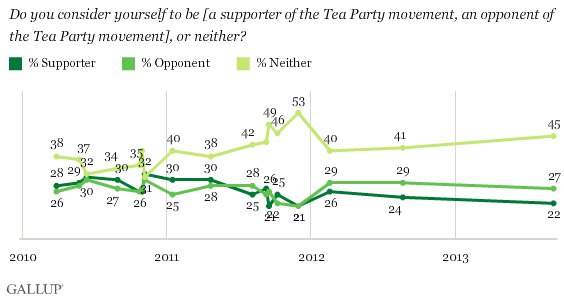Poll interpretation can mislead, but if you measure this one any of several ways, and you trust Gallup, the Tea Party is in a decline. Even before the debt debacle, in September 2013 polling, a total of 22% of voters supported them, while 27% outright opposed them. Even many Republicans chose to NOT list themselves as Tea Party supporters.

The percentage of voters that is neither for nor against them — our large undecided middle — totals in the mid 40 percent range, and that consistent over time. About half the population is unaligned, or doesn’t know enough to answer the question.
Compare the 22% support now, to the Tea Party heyday in January 2011 at 30% supporting and 25% opposed. January 2011 would represent the shining frontier for the Tea crowd as their newly elected representatives were in office and about to show their stuff. By November 2011, after their inclinations were becoming more obvious, those supporting and opposed to them dropped to a tie at 21%. That means overall support dropped almost 30% in one year. Since early in 2012, there has been a steady slow decline in supporters, and the opposition figures indicate consistently more enemies than friends.
As a Tea Party friend offered, using Tea Party math, that’s only a 7% difference between supporters and opponents, but an honest assessment is that the 22% support level is almost a 27% overall drop in their support, and puts them almost that much below their detractors in strength. And a great many of the unaligned do not favor Tea Party policies, but would stop short of saying they opposed the Party outright.
The Gallup figures show something else significant; among Tea Party supporters, a large percentage are not strong supporters. Of their 22% support in 2013, “strong” supporters and “not strong” supporters are evenly split at 11% of voters in each category. That has always been about the case with the Tea Party.
Their opponents, however, are more passionate. In September of 2013 they tallied 17% strongly opposed to them and 10% opposed but not strongly. That approximate split has also been fairly consistent.
When registered voters were asked in August 2011 if Tea Party support of a candidate would make them vote for a candidate, 23% said more likely, while a whopping 42% said less likely.
Even in its heyday, when more people supported the Tea Party than opposed it, it was a lukewarm movement if measured by activity of participants. During that time when they were first becoming a portion of the Republicans in congress, of the 30% of voters supporting at that time, only 10% of that number (3% of voters) were active in the movement. Most of that 30% supporting (27% of voters surveyed) listed themselves as not active. Active in the survey meant attending rallies, working on campaigns or contributing money.
Even before the 2010 elections, more than half of voters (54%) had noticed that the Republican Party had become more conservative. 40% couldn’t see that, probably conservatives. Only 19% of voters at that time saw the Tea Party as responsible for the GOP’s shift to the right, while almost twice as many (35%) felt it was something else. That something was probably named Barack Hussein Obama.
What emerges from the Gallup study is a picture of a group, small in real support, but with a footprint that looks fueled by money or influence from somewhere. The Koch factor comes to mind, or whoever funds those foundations so big on pushing liberty talk and indignation at the government. Groups like the American Family Association also work to maximize the core Tea Party issues. In much of the South, where Tea Party reasoning and anger has been around for decades, the locals figure they must be part of a majority nationwide, and are faithful they will prevail. It’s an easy mistake to make — in places in the south you can travel miles and not see a vocal white Democrat. In these areas Tea Party appeals and reasoning are the stuff of social interaction, as well as a political view. This special set of political tendencies should last for a long time in those areas, even as the national appeal wanes.
Edited/Published by: SB




